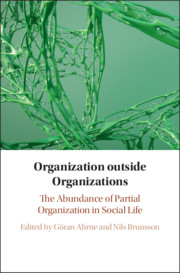Book contents
- Organization outside Organizations
- Organization outside Organizations
- Copyright page
- Contents
- Preface
- Contributors
- Introduction
- Part 1 Rules, Sanctions, Membership
- Part 2 Organization in and around Markets
- Part 3 Networks and Other Social Relationships
- Part 4 Social Movements and Collective Action
- Part 5 The Partial Organization of Formal Organizations
- Conclusion
- Index
- References
Part 4 - Social Movements and Collective Action
Published online by Cambridge University Press: 11 July 2019
- Organization outside Organizations
- Organization outside Organizations
- Copyright page
- Contents
- Preface
- Contributors
- Introduction
- Part 1 Rules, Sanctions, Membership
- Part 2 Organization in and around Markets
- Part 3 Networks and Other Social Relationships
- Part 4 Social Movements and Collective Action
- Part 5 The Partial Organization of Formal Organizations
- Conclusion
- Index
- References
Summary
Although the question whether organisation obstructs or supports social movement claims and mobilisation has long been debated, it is undeniable that some level of organisation exists in even the most radically horizontal social movements. Relatively little attention has been paid, however, to how movements operate in dealing with the tensions associated with the question of organisation, that is, how they seek to be effective in decision-making while maintaining or advancing inclusivity and participation. This chapter presents an analysis of the organising efforts of a timebank. With a particular focus on the production of organisation, we illustrate how a group vested on the idea of horizontal, non-hierarchical collective action is dealing with the coordination and decision-making challenges they meet over time.
Keywords
- Type
- Chapter
- Information
- Organization outside OrganizationsThe Abundance of Partial Organization in Social Life, pp. 291 - 356Publisher: Cambridge University PressPrint publication year: 2019



